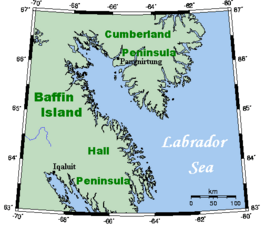Cumberland Sound facts for kids
Quick facts for kids Cumberland Sound |
|
|---|---|

Cumberland Sound, a part of the Labrador Sea, between Cumberland Peninsula and Hall Peninsula.
|
|
| Location | Labrador Sea |
| Coordinates | 65°13′N 065°45′W / 65.217°N 65.750°W |
| Basin countries | Canada |
| Settlements | Pangnirtung |
Cumberland Sound is a large waterway in the Arctic region of Canada. It is located in Nunavut, a northern territory. This sound is an arm of the Labrador Sea. It lies between two parts of Baffin Island: the Hall Peninsula and the Cumberland Peninsula.
The sound is about 250 km (160 mi) long and 80 km (50 mi) wide. Many small islands are scattered across its waters. Cumberland Sound was carved out by huge glaciers long ago. Meltwater from these glaciers helped shape the area as they moved away.
The only town located on the shore of Cumberland Sound is Pangnirtung. It is found on the Cumberland Peninsula.
Exploring Cumberland Sound
The English explorer John Davis sailed into Cumberland Sound in 1585. After his visit, Europeans did not return to the sound for a long time.
It was not until 1839 that the British whaler and explorer William Penny arrived. He was guided by an Inuit man named Eenoolooapik. Eenoolooapik told Penny that the sound, which he called Tenudiackbeek, was full of whales. Soon after, British whalers set up a station there to hunt whales.
Wildlife of the Sound
Cumberland Sound is home to many amazing animals. One special animal is the Cumberland Sound beluga whale. These whales live in the sound all year round. In the summer, they spend their time at the northern end of the sound.
You can also find different types of seals here. These include ringed, bearded, harp, harbour, and hooded seals. Many kinds of fish live in the waters too, such as Arctic char and Greenland halibut.
Birds also love Cumberland Sound. Gulls, ducks, and geese fly here in the spring and summer. They come to nest and raise their young. Other birds like ptarmigan and ravens stay in the sound all year long.
See also
 In Spanish: Cumberland Sound para niños
In Spanish: Cumberland Sound para niños



